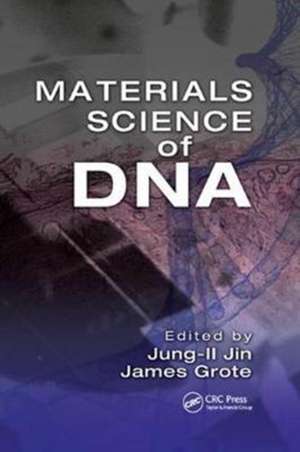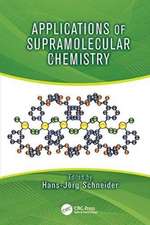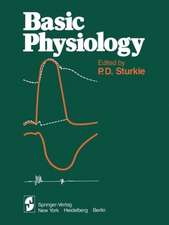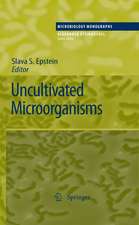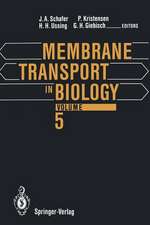Materials Science of DNA
Editat de Jung-II Jin, James Groteen Limba Engleză Paperback – 15 noi 2017
Materials Science of DNA highlights the most important subjects and perspectives in the field, with the aim of stimulating the interdisciplinary community and bringing this intensively interesting, emerging field of molecular-scale materials science to maturation. The editors have not only been involved in the research of materials science of DNA for the past decade, but also lead the series of International Biotronics Workshops supported by the US Air Force Research Laboratory.
Biotechnology and DNA-based biopolymers are not only applicable for genomic sequencing and clinical diagnosis and treatment, but can also have a major impact on nonbiotech applications—such as electronics and photonics— opening up a whole new field for bioengineering. New concepts and insights gained from DNA research are expected to prove genuinely useful in a variety of devices in nano, micro, and macro dimensions in the future. Where silicon has been the building block of inorganic electronics and photonics, DNA holds promise to become the building block for organic electronics and photonics.
| Toate formatele și edițiile | Preț | Express |
|---|---|---|
| Paperback (1) | 216.07 lei 6-8 săpt. | |
| CRC Press – 15 noi 2017 | 216.07 lei 6-8 săpt. | |
| Hardback (1) | 548.27 lei 6-8 săpt. | |
| CRC Press – 12 dec 2011 | 548.27 lei 6-8 săpt. |
Preț: 216.07 lei
Preț vechi: 379.25 lei
-43% Nou
Puncte Express: 324
Preț estimativ în valută:
41.35€ • 44.90$ • 34.73£
41.35€ • 44.90$ • 34.73£
Carte tipărită la comandă
Livrare economică 22 aprilie-06 mai
Preluare comenzi: 021 569.72.76
Specificații
ISBN-13: 9781138199187
ISBN-10: 1138199184
Pagini: 338
Ilustrații: 211
Dimensiuni: 156 x 234 x 28 mm
Greutate: 0.45 kg
Ediția:1
Editura: CRC Press
Colecția CRC Press
ISBN-10: 1138199184
Pagini: 338
Ilustrații: 211
Dimensiuni: 156 x 234 x 28 mm
Greutate: 0.45 kg
Ediția:1
Editura: CRC Press
Colecția CRC Press
Cuprins
Materials Science of DNA: An Introduction. Nanostructures and Nanomaterials via DNA-Based Self-Assembly. Intercalation of Organic Ligands as a Tool to Modify the Properties of DNA. DNA and Carbon-Based Nanomaterials: Preparation and Properties of Their Composites. Electrical and Magnetic Properties of DNA. DNA Ionic Liquid. DNA-Surfactant Thin-Film Processing and Characterization. Applications of DNA to Photonics and Biomedicals. DNA-Based Thin-Film Devices. Nucleic Acids-Based Biosensors. Materials Science of DNA—Conclusions and Perspectives.
Notă biografică
Jung-Il Jin is a Professor Emeritus, Chemistry Department of Korea University, Seoul, Korea. He is the immediate Past President of International Union of Pure and Applied Chemistry, IUPAC. He is the founding President of the Federation of the Asian Polymer Societies, FAPS. He obtained his Ph.D. in 1969 from the City University of New York (Advisor: Richard H. Wiley) and was a visiting professor at the University of Massachusetts, USA and the University of Cambridge, UK. His research areas have been liquid crystalline and polyconjugated polymers and materials science of DNA. He has published about 400 original research articles and contributed many chapters to various monographs related to functional polymers.
James G. Grote is a Principal Electronics Research Engineer with the Air Force Research Laboratory, Materials and Manufacturing Directorate at Wright-Patterson Air Force Base, Ohio, where he conducts research in polymer and biopolymer based opto-electronics. He is also an adjunct professor at the University of Dayton and University of Cincinnati. Dr. Grote received his BS degree in Electrical Engineering for Ohio University and both his MS and Ph.D. degrees in Electrical Engineering from the University of Dayton, with partial study at the University of California, San Diego. He was a visiting scholar at the Institut d’Optique, Universite de Paris, Sud in the summer of 1995 and a visiting scholar at the University of Southern California, the University of California in Los Angeles and the University of Washington in 2001. He received Doctor Honoris Causa from the Politehnica University of Bucharest in 2010. Dr. Grote is an Air Force Research Laboratory Fellow, a Fellow of the International Society for Optics and Photonics (SPIE), a Fellow of the Optical Society of America (OSA), a Fellow of the European Optical Society (EOS) and a Senior Member of the Institute of Electrical and Electronics Engineers (IEEE). He has co-authored more than 130 journal and conference papers, including 2 book chapters, and has served as editor for more than 25 conference proceedings and journal publications.
James G. Grote is a Principal Electronics Research Engineer with the Air Force Research Laboratory, Materials and Manufacturing Directorate at Wright-Patterson Air Force Base, Ohio, where he conducts research in polymer and biopolymer based opto-electronics. He is also an adjunct professor at the University of Dayton and University of Cincinnati. Dr. Grote received his BS degree in Electrical Engineering for Ohio University and both his MS and Ph.D. degrees in Electrical Engineering from the University of Dayton, with partial study at the University of California, San Diego. He was a visiting scholar at the Institut d’Optique, Universite de Paris, Sud in the summer of 1995 and a visiting scholar at the University of Southern California, the University of California in Los Angeles and the University of Washington in 2001. He received Doctor Honoris Causa from the Politehnica University of Bucharest in 2010. Dr. Grote is an Air Force Research Laboratory Fellow, a Fellow of the International Society for Optics and Photonics (SPIE), a Fellow of the Optical Society of America (OSA), a Fellow of the European Optical Society (EOS) and a Senior Member of the Institute of Electrical and Electronics Engineers (IEEE). He has co-authored more than 130 journal and conference papers, including 2 book chapters, and has served as editor for more than 25 conference proceedings and journal publications.
Descriere
As interest continues to grow, DNA is expected to become focal to nanobiotechnology because of its structural and chemical characteristics. With chapters written by experts in their respective fields, this text chiefly focuses on the rapidly growing fields of nanoscience, nanotechnology, and biotechnology. It is the first to address the materials science facet of DNA, rather than its chemical, biochemical, or biological aspects. It includes tables, graphs, equations, and an ancillary CD-ROM to provide understanding of DNA and the great potential of this biopolymer as advanced material.
